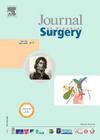2025年毛窦及复发的处理。
IF 2
4区 医学
Q2 SURGERY
引用次数: 0
摘要
毛突窦是臀间裂的常见病理,可发展为脓肿或化脓。这种病变在组织学上与异物(通常是毛发)周围形成的肉芽肿相对应,并通过部分上皮化的孔口向皮肤浸润。如果出现化脓和脓肿,治疗的基础要么是药物治疗结合止痛药,局部消毒剂,有时抗生素,或在手术室紧急切开和引流。在法国,每年有超过1万名患者接受这种手术。在非紧急情况下,选择性手术治疗毛突窦是为了治疗恼人的症状或避免脓肿复发的风险。手术指征必须考虑到患者的危险因素,特别是吸烟,这会增加术后并发症和复发的风险。在法国,每年有超过30,000名患者接受选择性干预。根治性切除后继发愈合是最常见的选择。这种策略至少有10%的患者有失败或复发的风险。切除后的初步闭合可以减少愈合和康复的时间,但代价是更频繁的感染并发症。应避免中线闭合,而应选择旁线闭合或皮瓣闭合。目前正在开发微创技术,将异物的取出与肉芽肿壁的机械清创或热或化学烧灼相结合。他们避免了对二次愈合伤口的复杂和不愉快的护理,代价是复发率相当于切除技术。它们的优点是避免了根治性切除后无法愈合或复发的困难情况,这些情况与生活质量的明显恶化有关。手术失败的治疗是复杂的,包括全面的病人护理(戒烟、抗感染治疗、治疗超重、避免久坐不动的生活方式)和经常重复手术。微创治疗,特别是激光治疗,在这些困难的情况下有其一席之地。本文章由计算机程序翻译,如有差异,请以英文原文为准。
Management of pilonidal sinus and recurrences in 2025
Pilonidal sinus is a common pathology of the intergluteal cleft that can develop into abscess or suppuration. This lesion corresponds histologically to a granuloma that organizes around foreign bodies, most often hairs, and fistulizes to the skin through partially epithelialized orifices. If suppuration and abscess develop, treatment is based either on medical treatment combining analgesics, local antiseptics and sometimes antibiotics, or on emergency incision and drainage in the operating room. This is performed in more than 10,000 patients per year in France. Outside of emergencies, elective surgery for pilonidal sinus is indicated to treat bothersome symptoms or to avoid the risk of recurrent abscess. The surgical indication must take into account the patient's risk factors, particularly active smoking, that increase the risk of postoperative complications and recurrence. Elective intervention is performed on more than 30,000 patients per year in France. Radical excision followed by secondary healing is the most commonly performed option. This strategy carries a risk of failure or recurrence for at least 10% of patients. Primary closure after excision can reduce the time for healing and convalescence, but at the cost of more frequent infectious complications. Midline closure should be avoided, in favor of paramedian or flap closure. Minimally invasive techniques are being developed that combine the extraction of foreign bodies and mechanical debridement or thermal or chemical cautery of the granulomatous walls. They avoid complex and unpleasant nursing care of secondarily healing wounds, at the cost of a recurrence rate equivalent to that from excision techniques. They have the merit of avoiding difficult situations of failure to heal or recurrence after radical excision that are associated with a clear deterioration in the quality of life. The treatment of surgical failures is complex, and combines comprehensive patient care (smoking cessation, anti-infectious treatments, treatment of excess weight, avoidance of a sedentary lifestyle) and often a repeat operation. Minimally invasive treatments, particularly laser treatments, have their place in these difficult situations.
求助全文
通过发布文献求助,成功后即可免费获取论文全文。
去求助
来源期刊

Journal of Visceral Surgery
SURGERY-
CiteScore
2.00
自引率
9.50%
发文量
108
审稿时长
>12 weeks
期刊介绍:
The Journal of Visceral Surgery (JVS) is the online-only, English version of the French Journal de Chirurgie Viscérale. The journal focuses on clinical research and continuing education, and publishes original and review articles related to general surgery, as well as press reviews of recently published major international works. High-quality illustrations of surgical techniques, images and videos serve as support for clinical evaluation and practice optimization.
JVS is indexed in the main international databases (including Medline) and is accessible worldwide through ScienceDirect and ClinicalKey.
 求助内容:
求助内容: 应助结果提醒方式:
应助结果提醒方式:


